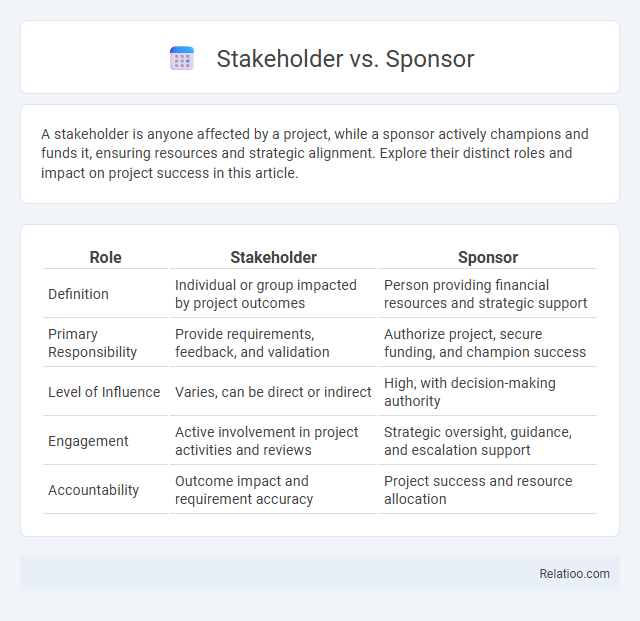A stakeholder is anyone affected by a project, while a sponsor actively champions and funds it, ensuring resources and strategic alignment. Explore their distinct roles and impact on project success in this article.
Table of Comparison
| Role | Stakeholder | Sponsor |
|---|---|---|
| Definition | Individual or group impacted by project outcomes | Person providing financial resources and strategic support |
| Primary Responsibility | Provide requirements, feedback, and validation | Authorize project, secure funding, and champion success |
| Level of Influence | Varies, can be direct or indirect | High, with decision-making authority |
| Engagement | Active involvement in project activities and reviews | Strategic oversight, guidance, and escalation support |
| Accountability | Outcome impact and requirement accuracy | Project success and resource allocation |
Understanding Stakeholders and Sponsors
Understanding stakeholders involves identifying individuals or groups impacted by a project, while sponsors are key stakeholders who provide financial support and strategic direction. Defining ground rules early ensures clear expectations and effective communication between your team and all parties involved. Properly distinguishing between stakeholders and sponsors helps align project goals and secures essential resources for success.
Key Definitions: Stakeholder vs Sponsor
A stakeholder is any individual or group with an interest or influence in a project's outcome, encompassing sponsors, team members, customers, and suppliers. A sponsor specifically refers to a key stakeholder who provides financial resources, support, and strategic direction to ensure project success. Ground rules are established guidelines that govern team behavior and communication to maintain effective collaboration throughout the project lifecycle.
Roles and Responsibilities
Stakeholders are individuals or groups impacted by a project who provide input and feedback, ensuring alignment with organizational goals. Sponsors are key decision-makers responsible for securing funding, championing the project, and resolving high-level issues to drive success. Ground rules establish agreed-upon behaviors and communication standards, facilitating effective collaboration and accountability among team members and stakeholders.
Influence on Project Success
Stakeholders impact your project success by affecting decisions, resources, and acceptance, while sponsors provide crucial financial support, strategic direction, and authority to remove obstacles. Ground rules establish agreed-upon expectations and behaviors, creating an environment that fosters collaboration and minimizes conflicts. Understanding and managing the influence of stakeholders, sponsors, and ground rules is essential for achieving project objectives efficiently.
Levels of Engagement
Stakeholders have varying levels of engagement, ranging from passive observers to active participants directly influencing the project's success. Sponsors typically maintain a high level of engagement by providing strategic direction, resources, and decision-making support essential for project alignment with organizational goals. Your understanding of ground rules establishes clear expectations that guide stakeholder and sponsor interactions, ensuring consistent collaboration and commitment at every engagement level.
Decision-Making Authority
Stakeholders influence project outcomes through their interests and impact, while sponsors hold formal decision-making authority, providing resources and strategic direction critical for project success. Ground rules establish clear expectations and protocols, ensuring that decision-making processes are transparent, consistent, and respected by all team members. Your understanding of these roles enhances effective governance and accountability within project management.
Communication Channels
Effective communication channels in project management distinguish stakeholders, sponsors, and ground rules by their distinct roles and interactions. Stakeholders require tailored communication strategies to address their diverse interests and influence, while sponsors need direct, high-level updates to support decision-making and resource allocation. Ground rules establish clear protocols and preferred communication methods, ensuring consistent information flow and reducing misunderstandings among all project participants.
Managing Expectations
Managing expectations among stakeholders, sponsors, and project teams hinges on clear communication and defined ground rules that outline roles and responsibilities. Stakeholders influence project outcomes and require consistent updates to align their interests, while sponsors provide financial backing and strategic direction, necessitating transparent reporting on progress and risks. Establishing ground rules fosters accountability and minimizes misunderstandings, ensuring all parties have a shared understanding of deliverables, timelines, and decision-making processes.
Common Challenges and Solutions
Confusion between stakeholders, sponsors, and ground rules often leads to miscommunication and project delays. Common challenges include unclear roles, lack of stakeholder engagement, and inconsistent enforcement of ground rules, which hinder progress and accountability. Implementing clear communication plans, defining roles explicitly in project charters, and regularly reviewing ground rules with all participants fosters alignment and enhances project success.
Best Practices for Collaboration
Effective collaboration hinges on clearly defining the roles of stakeholders, sponsors, and ground rules to ensure aligned expectations and accountability. Stakeholders actively influence project decisions and outcomes, while sponsors provide essential resources and executive support; establishing ground rules fosters respectful communication and mutual trust. Your best practice is to engage stakeholders regularly, keep sponsors informed of key milestones, and collaboratively develop ground rules that promote transparency and shared responsibility throughout the project lifecycle.

Infographic: Stakeholder vs Sponsor
 relatioo.com
relatioo.com